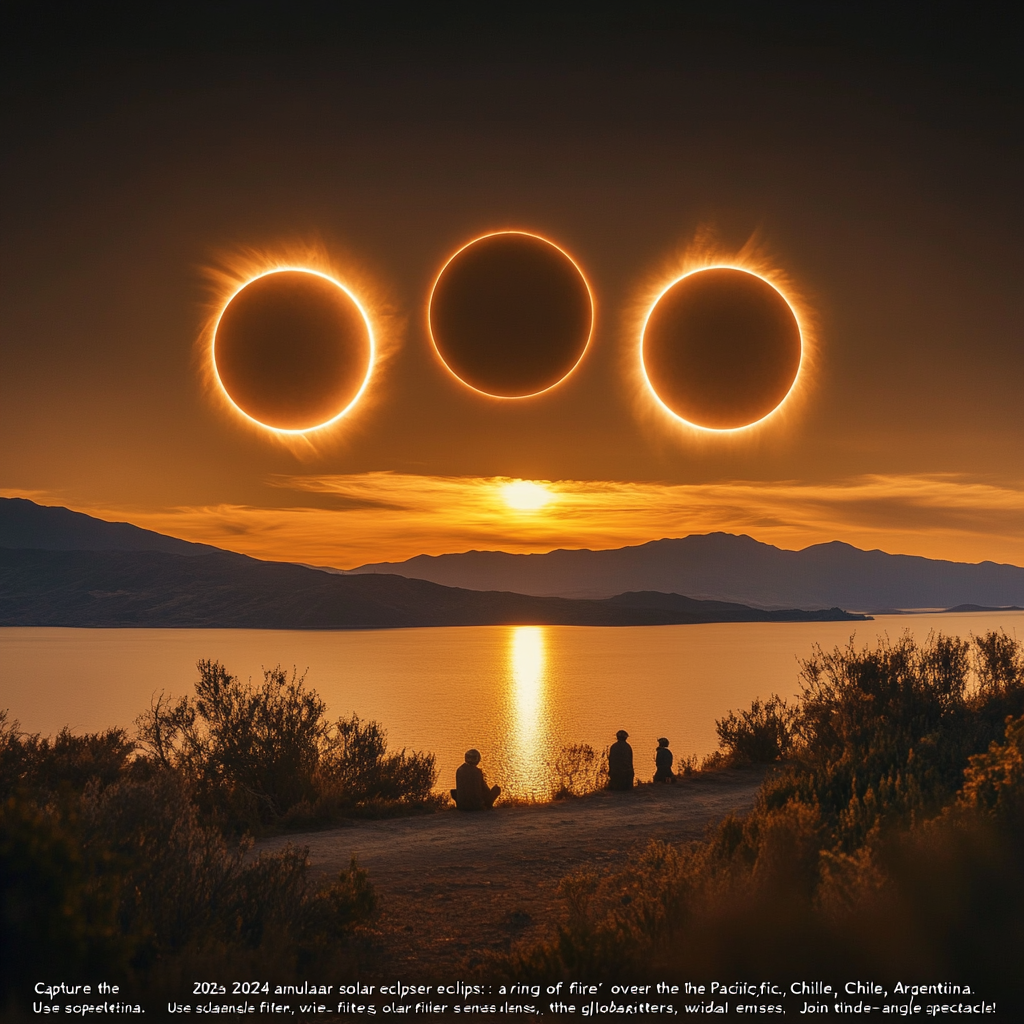
2024 Solar Eclipse: Spectacular ‘Ring of Fire’ Images
The Breathtaking Annular Solar Eclipse of 2024: A 'Ring of Fire' Spectacle
Have you ever witnessed a celestial spectacle that leaves you breathless? Well, folks, mark your calendars for October 2, 2024, because the skies over parts of the Pacific Ocean and the sprawling landscapes of southern Chile and Argentina are set to present one of nature's most jaw-dropping displays: the annular solar eclipse, affectionately dubbed the "ring of fire." This event won't merely be a checkmark on the astronomical calendar; it'll be a dazzling, unforgettable performance that makes the heart race and eyes widen in awe.
What on Earth (or rather, in Space) is an Annular Solar Eclipse?
To put it simply, an annular solar eclipse is a type of solar eclipse that occurs when the moon, at its most distant point from our planet (what astrophysicists like to call apogee), slides directly between the Earth and the sun. But here’s the kicker—it doesn’t completely cover the sun’s disk. Instead, it leaves that glorious orb shining around the edges—the infamous "ring of fire." Yes, that bright, fiery ring seems like something straight out of a fairy tale, a visual treat that any sightseer or celestial buff would chase to the ends of the Earth to witness.
The Path of Annularity: A Glimpse of Cosmic Exclusivity
Now, let’s talk about where you would need to be to catch this glorious sight. The path of annularity is like a cosmic runway that runs rather narrowly across the Earth, making it a bit exclusive and a tad rare for the average individual. It will grace parts of the Pacific Ocean, hover tantalizingly over Rapa Nui (that's Easter Island for the uninitiated), then roll its way through the beautiful terrains of southern Chile and Argentina. With only about 175,000 souls residing within this path, the opportunity to experience this magnificent phenomenon becomes a precious gem that only a few will claim.
A Call to Action for Photographers and Skywatchers
For all the avid sky enthusiasts and Instagram-ready photographers out there, the excitement leading up to this event is palpable. Imagine the frantic race to set your cameras in ideal positions, your heart thumping like a bass drum as the time draws near. Award-winning shutterbug Josh Dury, for instance, is set to brave the elements on Rapa Nui. His mission? To document the beauty of this celestial event alongside local guides—because nothing beats the thrill of capturing a moment that transcends time and space. Photographers like Jonathan Martins are gearing up to shoot the entire sequence of the eclipse while Juan Mabromata may just snap the magical "ring of fire" from Puerto San Julián in Argentina. Talk about a photo op that will have your social media following envious!
Let’s Talk Techniques: Getting the Shot of a Lifetime
Ah, capturing an eclipse isn't just about having a fancy camera and an Instagram account. Oh no, my friend, it’s a dance between technology and technique! The pros use all sorts of specialized equipment to secure those stunning shots. Take Aditya Madhavan, an astrophotographer who understands that you can’t just point and shoot. He uses a Lunt H-alpha telescope during the event. Why, you ask? Well, it’s all about that intricate view of the sun’s chromosphere and those dazzling solar prominences—delicate structures that reveal themselves only under specific wavelengths. Like drawing back a velvet curtain to unveil an exquisite performance on stage, this technique demonstrates the sun’s true majesty.
Baily's Beads and Daring Sunspots: The Details Matter!
Oh, and don't get lost in the grandeur without paying attention to the delightful subtleties! During the partial phase of the eclipse, don’t forget to watch for Baily's beads—those twinkling points of sunlight peeking through the high peaks and valleys of the moon. They create this spellbinding, glittering effect that’ll have you questioning whether you’re actually staring at the sun or peering into a cosmic gemstone. And let’s not forget about sunspots. What are they? Well, think of them as the sun’s own tiny blemishes—dark regions with strong magnetic fields that can create dramatic solar flares and coronal mass ejections (CMEs). Not something to ignore while you have your eyes fixed on the majestic ring!
The Anticipation: A Moment of Cosmic Joy
Now, let’s take a moment to set the scene. Imagine skywatchers, an eclectic mix of science geeks, families, and the occasional UFO enthusiast, waiting with baited breath as the moment of annularity approaches. The tension is almost tangible—like the stillness right before a storm. Eclipse expert Jamie Carter describes this high-stakes environment, where every second counts and every cloud that drifts by feels like a personal affront. The stakes rise as roiling clouds begin to tease the arrival of the "ring of fire," and just when you think luck may not be in your favor, the heavens open, revealing an unblemished view. Are you feeling the chills yet?
A Historic Event for Rapa Nui
For Rapa Nui, this isn’t just an eclipse anymore; it’s a monumental occasion, as the island hasn’t seen an annular solar eclipse since 1788. Considering the long, expansive reach of time, can you imagine how much anticipation must be buzzing among the locals? And for those who think they can just wait it out, guess what? The next occurrence won’t be until 2345! Those human-faced moai statues probably have more anticipated stories to share than we know, and on this day, they become part of a collective witnessing of cosmic grandeur.
A Global Affair: Who Else Gets to See It?
While the "ring of fire" will undoubtedly steal the show in South America, other regions are not entirely missing out on this cosmic festivity. Hawaii has the satisfaction of soaking in a partial eclipse, and various territories and countries scattering across the Pacific and South America will catch glimpses too. We’re talking about an event that captures the imagination of dreamers worldwide!
Future Eclipses: Don’t Miss the Next Cosmic Showdown
All of this talk about eclipses has your inner astronomer buzzing, doesn’t it? If you’re feeling a surge of inspiration or just plain enthusiasm to grab your camera and try your hand at celestial photography, breathe easy. The universe isn’t done dazzling us yet! There are still upcoming eclipses on the horizon. Keep your eyes peeled for partial solar eclipses in 2025 and a total solar eclipse in 2026. And the pièce de résistance? The much-talked-about "eclipse of the century" occurring in 2027. Now that’s something to keep the adrenaline pumping!
In summary, the solar annular eclipse of 2024 is not just another celestial event to observe. It’s an invitation to delve into the wonders of our universe, a chance to become part of something monumental, something that elicits awe and wonder in even the most hardened skeptics. For those lucky enough to observe it—and those brave souls who will photograph it—it speaks to our innate desire to connect with the cosmos. The "ring of fire" isn’t just a mere occurrence; it’s a celebration of the vast, intriguing universe we inhabit.
Want to stay up to date with the latest news on astronomical events and more? Subscribe to our Telegram channel: @channel_neirotoken

